人教版选修六unit1_Art_Reading
- 格式:ppt
- 大小:13.68 MB
- 文档页数:37
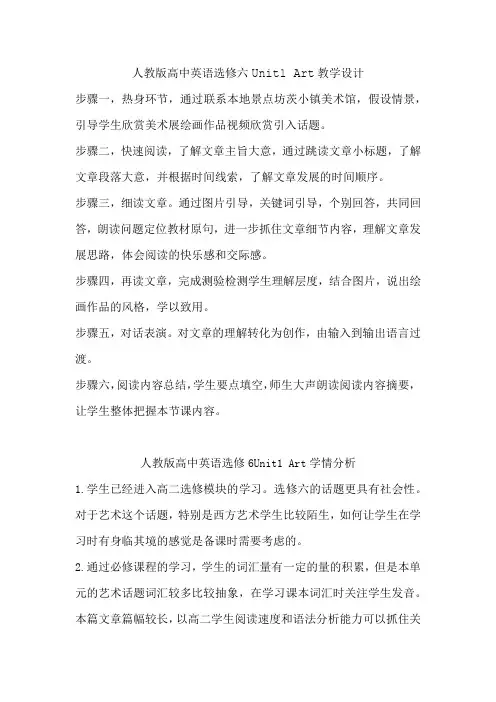
人教版高中英语选修六Unit1 Art教学设计步骤一,热身环节,通过联系本地景点坊茨小镇美术馆,假设情景,引导学生欣赏美术展绘画作品视频欣赏引入话题。
步骤二,快速阅读,了解文章主旨大意,通过跳读文章小标题,了解文章段落大意,并根据时间线索,了解文章发展的时间顺序。
步骤三,细读文章。
通过图片引导,关键词引导,个别回答,共同回答,朗读问题定位教材原句,进一步抓住文章细节内容,理解文章发展思路,体会阅读的快乐感和交际感。
步骤四,再读文章,完成测验检测学生理解层度,结合图片,说出绘画作品的风格,学以致用。
步骤五,对话表演。
对文章的理解转化为创作,由输入到输出语言过渡。
步骤六,阅读内容总结,学生要点填空,师生大声朗读阅读内容摘要,让学生整体把握本节课内容。
人教版高中英语选修6Unit1 Art学情分析1.学生已经进入高二选修模块的学习。
选修六的话题更具有社会性。
对于艺术这个话题,特别是西方艺术学生比较陌生,如何让学生在学习时有身临其境的感觉是备课时需要考虑的。
2.通过必修课程的学习,学生的词汇量有一定的量的积累,但是本单元的艺术话题词汇较多比较抽象,在学习课本词汇时关注学生发音。
本篇文章篇幅较长,以高二学生阅读速度和语法分析能力可以抓住关键信息和细节。
课文内容的深入理解和写作思路的把握需要老师的引导。
主动阅读和探究式阅读的习惯在逐步养成。
3.学生的语言输出能力相对输入能力较弱,在说和写方面有待刺激和加强。
尤其是在享受阅读的环节上,需要教师进行大量的鼓励和刺激。
人教版高中英语选修6 Unit1Art效果分析1. 语言知识与技能恰当使用有关绘画方面的词汇,gallery、abstract 等,能理解课文内容,运用听说读写等各项技能,完成课标要求的各项任务,重难点完成很好。
参与热情高,师生互动,生生互动效果理想。
兼顾了不同学习水平的学生的学习方法和能力。
既有传统的速读和细读环节,也有学生话题知识能力生成环节如小组合作和课堂对话展示。
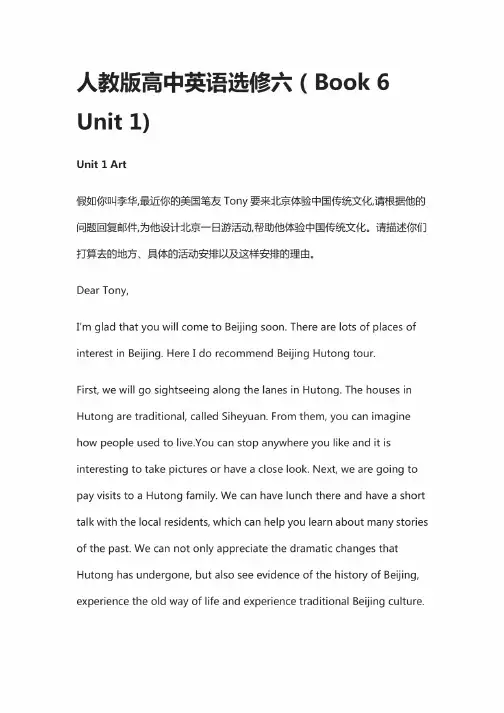
人教版高中英语选修六(Book6 Unit1)Unit1Art假如你叫李华,最近你的美国笔友Tony要来北京体验中国传统文化,请根据他的问题回复邮件,为他设计北京一日游活动,帮助他体验中国传统文化。
请描述你们打算去的地方、具体的活动安排以及这样安排的理由。
Dear Tony,I'm glad that you will come to Beijing soon.There are lots of places of interest in Beijing.Here I do recommend Beijing Hutong tour.First,we will go sightseeing along the lanes in Hutong.The houses in Hutong are traditional,called Siheyuan.From them,you can imagine how people used to live.You can stop anywhere you like and it is interesting to take pictures or have a close look.Next,we are going to pay visits to a Hutong family.We can have lunch there and have a short talk with the local residents,which can help you learn about many stories of the past.We can not only appreciate the dramatic changes that Hutong has undergone,but also see evidence of the history of Beijing, experience the old way of life and experience traditional Beijing culture.In a word,Hutongs are the homes of common people in the past.It is easy to know how people lived and had fun in the old days.So it is a good choice to learn about traditional Chinese culture.I'm looking forward to your coming.Yours,Li Hua1.文章体裁:应用文——电子邮件。
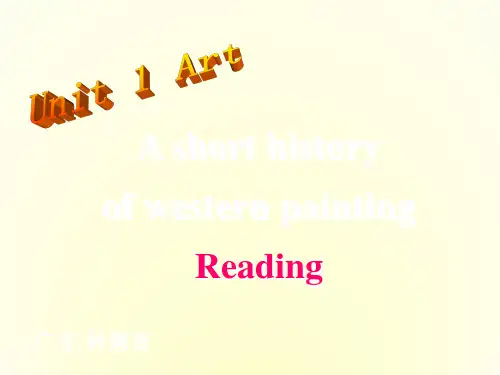
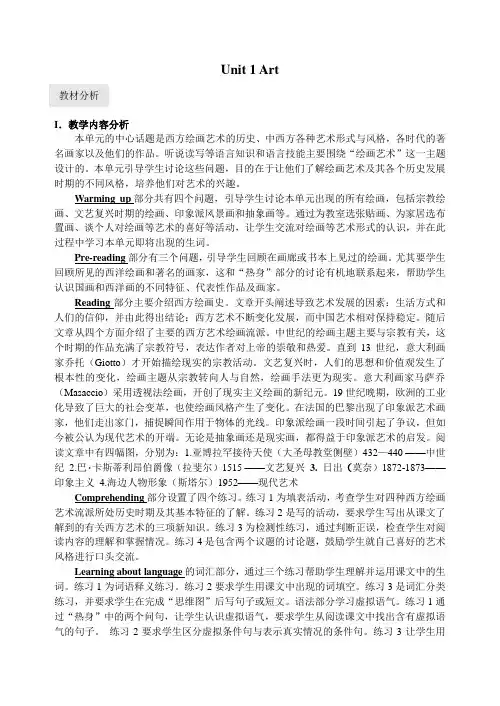
Unit 1 Art教材分析I.教学内容分析本单元的中心话题是西方绘画艺术的历史、中西方各种艺术形式与风格,各时代的著名画家以及他们的作品。
听说读写等语言知识和语言技能主要围绕“绘画艺术”这一主题设计的。
本单元引导学生讨论这些问题,目的在于让他们了解绘画艺术及其各个历史发展时期的不同风格,培养他们对艺术的兴趣。
Warming up部分共有四个问题,引导学生讨论本单元出现的所有绘画,包括宗教绘画、文艺复兴时期的绘画、印象派风景画和抽象画等。
通过为教室选张贴画、为家居选布置画、谈个人对绘画等艺术的喜好等活动,让学生交流对绘画等艺术形式的认识,并在此过程中学习本单元即将出现的生词。
Pre-reading部分有三个问题,引导学生回顾在画廊或书本上见过的绘画。
尤其要学生回顾所见的西洋绘画和著名的画家,这和“热身”部分的讨论有机地联系起来,帮助学生认识国画和西洋画的不同特征、代表性作品及画家。
Reading部分主要介绍西方绘画史。
文章开头阐述导致艺术发展的因素:生活方式和人们的信仰,并由此得出结论:西方艺术不断变化发展,而中国艺术相对保持稳定。
随后文章从四个方面介绍了主要的西方艺术绘画流派。
中世纪的绘画主题主要与宗教有关,这个时期的作品充满了宗教符号,表达作者对上帝的崇敬和热爱。
直到13世纪,意大利画家乔托(Giotto)才开始描绘现实的宗教活动。
文艺复兴时,人们的思想和价值观发生了根本性的变化,绘画主题从宗教转向人与自然,绘画手法更为现实。
意大利画家马萨乔(Masaccio)采用透视法绘画,开创了现实主义绘画的新纪元。
19世纪晚期,欧洲的工业化导致了巨大的社会变革,也使绘画风格产生了变化。
在法国的巴黎出现了印象派艺术画家,他们走出家门,捕捉瞬间作用于物体的光线。
印象派绘画一段时间引起了争议,但如今被公认为现代艺术的开端。
无论是抽象画还是现实画,都得益于印象派艺术的启发。
阅读文章中有四幅图,分别为:1.亚博拉罕接待天使(大圣母教堂侧壁)432—440 ——中世纪 2.巴۰卡斯蒂利昂伯爵像(拉斐尔)1515 ——文艺复兴3. 日出(莫奈)1872-1873——印象主义4.海边人物形象(斯塔尔)1952——现代艺术Comprehending部分设置了四个练习。

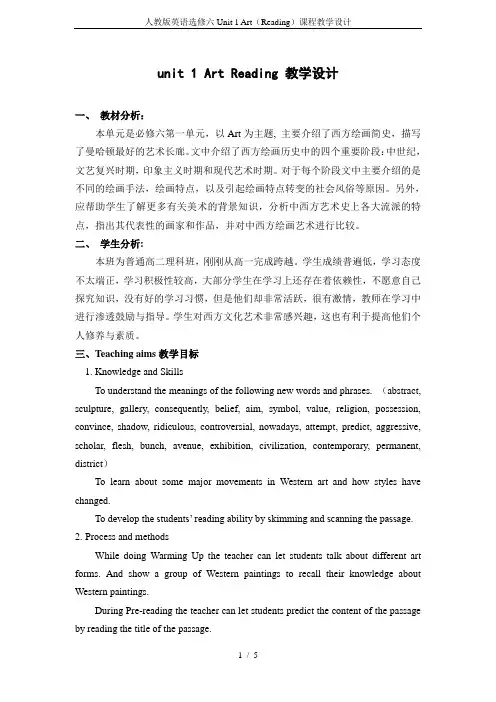
unit 1 Art Reading 教学设计一、教材分析:本单元是必修六第一单元,以Art为主题, 主要介绍了西方绘画简史,描写了曼哈顿最好的艺术长廊。
文中介绍了西方绘画历史中的四个重要阶段:中世纪,文艺复兴时期,印象主义时期和现代艺术时期。
对于每个阶段文中主要介绍的是不同的绘画手法,绘画特点,以及引起绘画特点转变的社会风俗等原因。
另外,应帮助学生了解更多有关美术的背景知识,分析中西方艺术史上各大流派的特点,指出其代表性的画家和作品,并对中西方绘画艺术进行比较。
二、学生分析:本班为普通高二理科班,刚刚从高一完成跨越。
学生成绩普遍低,学习态度不太端正,学习积极性较高,大部分学生在学习上还存在着依赖性,不愿意自己探究知识,没有好的学习习惯,但是他们却非常活跃,很有激情,教师在学习中进行渗透鼓励与指导。
学生对西方文化艺术非常感兴趣,这也有利于提高他们个人修养与素质。
三、Teaching aims教学目标1. Knowledge and SkillsTo understand the meanings of the following new words and phrases. (abstract, sculpture, gallery, consequently, belief, aim, symbol, value, religion, possession, convince, shadow, ridiculous, controversial, nowadays, attempt, predict, aggressive, scholar, flesh, bunch, avenue, exhibition, civilization, contemporary, permanent, district)To learn about some major movements in Western art and how styles have changed.To develop the students’ reading ability by skimming and scanning the passage. 2.Process and methodsWhile doing Warming Up the teacher can let students talk about different art forms. And show a group of Western paintings to recall their knowledge about Western paintings.During Pre-reading the teacher can let students predict the content of the passage by reading the title of the passage.Reading and comprehending: the teacher asks students to read the passage quickly to get its structure. After that, the teacher lets students read carefully to get more detailed information.Post-reading: let student retell the passage in their own words at the end of the class.3.Emotion, attitude and valueTo stimulate students’ sense of beauty and the ability of understanding, enjoying and creating beauty.To develop students’ sense cooperation learning.四、Teaching important points教学重点1. Enable the students to grasp the new words and impressions.2. Try to get the main idea of the text and improve the students’ reading abilities.五、Teaching difficult points教学难点1. Help the students learn how to talk about the short history of Western painting.2. Enable the students to talk about their opinions about different styles of Western art.六、Teaching aids 教具The multimedia , blackboard七、Teaching method教学方法Task-Based Language Teaching, Skimming and scanning, Discussion八、Teaching procedures教学过程Step 1. GreetingsGood morning, everyone! So happy to see you here.Step 2. RevisionLast class, we have learned the new words, now let us have a short review. Please open your book and turn to page 89, and read follow me.设计意图:本班学生基础较差,基础的单词必须每节课都巩固,上课读一遍,加强记忆,有助于更好理解课文,并且为以后学习打好基础。
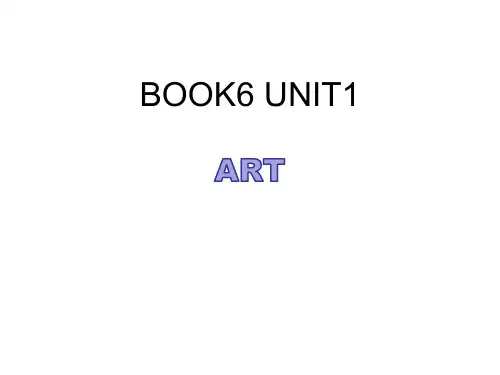
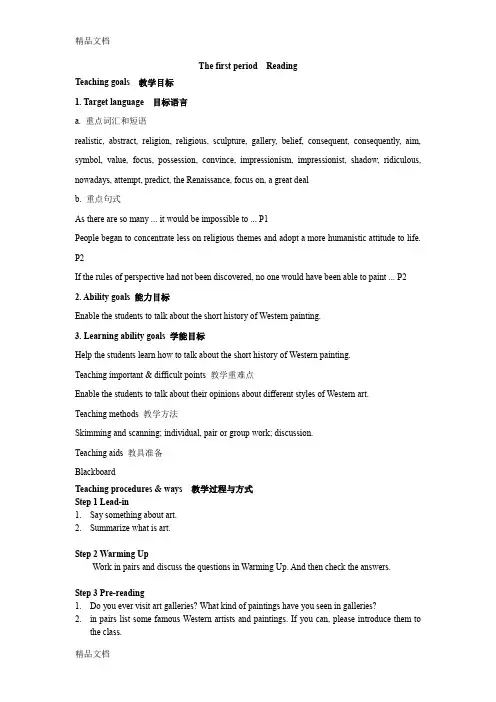
The first period ReadingTeaching goals 教学目标1. Target language 目标语言a. 重点词汇和短语realistic, abstract, religion, religious, sculpture, gallery, belief, consequent, consequently, aim, symbol, value, focus, possession, convince, impressionism, impressionist, shadow, ridiculous, nowadays, attempt, predict, the Renaissance, focus on, a great dealb. 重点句式As there are so many ... it would be impossible to ... P1People began to concentrate less on religious themes and adopt a more humanistic attitude to life. P2If the rules of perspective had not been discovered, no one would have been able to paint ... P2 2. Ability goals 能力目标Enable the students to talk about the short history of Western painting.3. Learning ability goals 学能目标Help the students learn how to talk about the short history of Western painting.Teaching important & difficult points 教学重难点Enable the students to talk about their opinions about different styles of Western art.Teaching methods 教学方法Skimming and scanning; individual, pair or group work; discussion.Teaching aids 教具准备BlackboardTeaching procedures & ways 教学过程与方式Step 1 Lead-in1.Say something about art.2.Summarize what is art.Step 2 Warming UpWork in pairs and discuss the questions in Warming Up. And then check the answers.Step 3 Pre-reading1.Do you ever visit art galleries? What kind of paintings have you seen in galleries?2.in pairs list some famous Western artists and paintings. If you can, please introduce them tothe class.Step 4 Reading2.Read the text carefully again and answer the questions.(1) What were the artists interested in from 5th to 15th century AD?(2) How did Masaccio paint his paintings?(3) Why did the impressionists have to paint quickly?3. According to the text, finish exercise 3 on page 3 by yourselves. Then check the answers.4. What is the writing style of the passage?------The passage is a historical narrative article. It briefly introduces the main features of different Western painting styles during the main periods of times. It also analyzes why and how the styles changed. The short history of Western painting styles is described clearly and vividly, which gives the readers deep impression.5. How about its writing characteristic?------The writing characteristic of it is: Arranged well in the order of time; Catch the features of people and things and use adjectives very exactly; Lay the stress on the main subjects and purpose, writing details and briefs properly; Insert the typical paintings to make the passage more vivid and lively.Step 5 Homework1. Underline the time expressions in the reading passage.2. Retell the passage with the help of the chart about the text.3. Memorize the new words and expressions.。
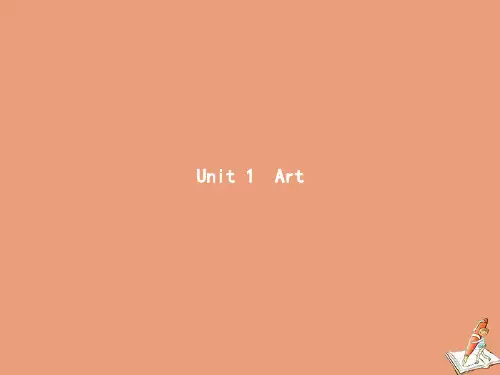
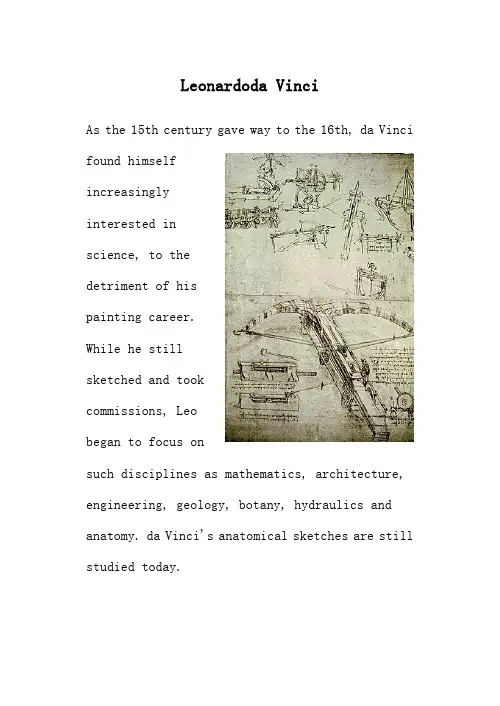
Leonardoda VinciAs the 15th century gave way to the 16th, da Vinci found himselfincreasinglyinterested inscience, to thedetriment of hispainting career.While he stillsketched and tookcommissions, Leobegan to focus onsuch disciplines as mathematics, architecture, engineering, geology, botany, hydraulics and anatomy. da Vinci's anatomical sketches are still studied today.To better inform his studies of bone and musculature, Leonardo dissected several cadavers, a practice that was still quite controversial at the time. However, for the most part, da Vinci avoided the sort of religious and political rows that would plague other scientists of the period, like Galileo.Leonardo's fascination with science led him down many dead-ends, but also to quite a few useful discoveries. da Vinci is credited with a number of inventions that were firsts for his time, including some so far ahead of his time that they wouldn't actually be built for centuries. They include:•The jack, the same device that you use today to change a tire•Roller bearings, a ball-bearing driven axle that is extremely similar to what cars usetoday•The one-man printing press•Mechanical transmissions, i.e. the gear system used in everything from ten-speeds toautomobiles•The odometerIn addition to these still-employed devices, da Vinci invented a series of scientific instruments for measuring everything from tensile strength tohumidity.At least asimpressive as theinventions thatworked were theinventions thatdidn't work. Although he lacked several key components and raw materials, da Vinci nevertheless envisioned a series of inventions that would eventually be used in the modern world, sometimes with only minor changes to his original designs, including the helicopter, thehang-glider and the machine gun.Leonardo collected his technological innovations in notebooks called codeci. One of the best preserved is the Codex Leicester, deals with everything from fossils to astronomy, included sketches of the how the moon's light is seen from earth, and the properties of water and rocks. For many years, the Codex Leicester was owned by Armand Hammer who called it the Codex Hammer from 1980 until his death; in 1994, it was bought by Bill Gates, who returned its original name.da Vinci had become an extremely celebrated artist by the time he entered middle age, and in Italy, there was only one more realm for him to conquer: Rome. In 1513, da Vinci entered the patronage of Pope Leo X, a scion of the wealthy and powerful Medici family. At the Vatican, Leonardo had mixed successes. Artistically, he found himself dominated by his rivals, Michelangelo and Raphael. Although he received several commissions for paintings, he also spent a lot of time on architectureandengineering.One of the fewpaintings hecompleted inthis period was"St. John the Baptist," another controversial work which has been the subject of much discussion over the years. Catty observers often cite the painting as one indication of Leonardo's gayness, which isn't really so controversial that it needs to be continually re-proven. In the work, John appears to be sexually ambiguous, soft and feminine, with a decidedly "come hither" expression.After a couple of years, Leonardo left Rome under the patronage of Giuliano Medici, the Pope's brother, where he appears to have spent the last years of his life quietly.For the last decade of da Vinci's life, his constant companion (and presumed lover) was a much younger man named Francesco Melzi, whose life is mostly distinguished by that relationship. He was reportedly an extremely good looking guy, a minornobleman from Milan and a talented amateur artist. After Leonardo died, Melzi inherited everything, including the inventions, the codeci, books and numerous drawings and paintings, which he carefully preserved for posterity.Leo was a pretty interesting guy in life, but in death, he took on mythic proportions. For centuries, various untrue legends surrounding his life and his works, including a variety of spurious claims about his death and many forgeries of his work. Among the bullet points you can cross off your list of "things to believe," da Vinci did not die in the arms of the king of France, he didn't invent the bicycle, and he didn't use the same model for Judas as he did for Jesus in "The Last Supper."In the 20th century, Leonardo has been an obsessive figure in the pages of fiction, with appearances in everything from Star Trek to a Saturday morning cartoon of Bill and Ted's Excellent Adventure.One of the Teenage Mutant Ninja Turtles was named after da Vinci. Between fiction and nonfiction, Leonardo has been featured in hundreds of movies and television shows, and tens of thousands of books. And with the breakout success of The da Vinci Code, and a movie adaptation on the way... Well, let's just say it won't be long before you're really fucking sick of Leonardo da Vinci. If you aren't already.。
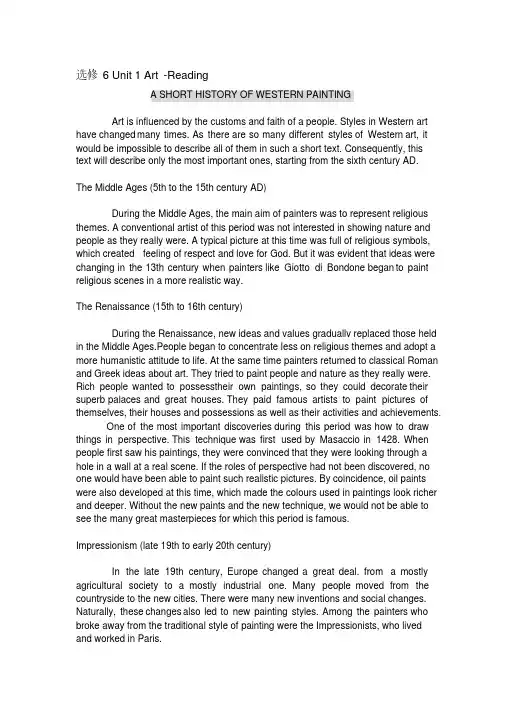
选修6 Unit 1 Art-ReadingA SHORT HISTORY OF WESTERN PAINTINGArt is influenced by the customs and faith of a people. Styles in Western art have changed many times. As there are so many different styles of Western art, it would be impossible to describe all of them in such a short text. Consequently, this text will describe only the most important ones, starting from the sixth century AD.The Middle Ages (5th to the 15th century AD)During the Middle Ages, the main aim of painters was to represent religious themes. A conventional artist of this period was not interested in showing nature and people as they really were. A typical picture at this time was full of religious symbols, which created feeling of respect and love for God. But it was evident that ideas were changing in the 13th century when painters like Giotto di Bondone began to paint religious scenes in a more realistic way.The Renaissance (15th to 16th century)During the Renaissance, new ideas and values graduallv replaced those held in the Middle Ages.People began to concentrate less on religious themes and adopt a more humanistic attitude to life. At the same time painters returned to classical Roman and Greek ideas about art. They tried to paint people and nature as they really were. Rich people wanted to possess t heir own paintings, so they could decorate their superb palaces and great houses. They paid famous artists to paint pictures of themselves, their houses and possessions as well as their activities and achievements.One of the most important discoveries during this period was how to draw things in perspective. This technique was first used by Masaccio in 1428. When people first saw his paintings, they were convinced that they were looking through a hole in a wall at a real scene. If the roles of perspective had not been discovered, no one would have been able to paint such realistic pictures. By coincidence, oil paints were also developed at this time, which made the colours used in paintings look richer and deeper. Without the new paints and the new technique, we would not be able to see the many great masterpieces for which this period is famous.Impressionism (late 19th to early 20th century)In the late 19th century, Europe changed a great deal. from a mostly agricultural society to a mostly industrial one. Many people moved from the countryside to the new cities. There were many new inventions and social changes. Naturally, these changes also led to new painting styles. Among the painters who broke away from the traditional style of painting were the Impressionists, who lived and worked in Paris.The Impressionists were the first painters to work outdoors. They were eager to show how light and shadow fell on objects at different times of day. However, because natural light changes so quickly, the Impressionists had to paint quickly. Their paintings were not as detailed as those of earlier painters. At first, many people disliked this style of painting and became very angr about it. They said that the painters were careless and their paintings were ridiculous.Modern Art (20th century to today)At the time they were created, the Impressionist paintings were controversial, but today they are accepted as the beginning of what we call "modem art". This is because t he Impressionists encouraged artists to look at their environment in new ways. There are scores of modern art styles, but without the Impressionists, many of these painting styles might not exist. On the one hand, some modem art is abstract; that is, the painter does not attempt to paint objects as we see them with our eyes, but instead concentrates on certain qualities of the object, using colour, line and shape to represent them. On the other hand, some paintings of modern art are so realistic that they look like photographs. These styles are so different. Who can predict what painting styles there will be in the future?THE BEST OF MANHATTAN’S ART GALLERIESThe Frick Collection (5th Avenue and E.70th Street)Many art lovers would rather visit this small art gallery than any other in New York. Henry Clay Frick, a rich New Yorker, died in 1919, leaving his house, furniture and art collection to the American people. Frick had a preference for pre-twentieth century Western paintings, and these are well-represented in this excellent collection. You can also explore Frick's beautiful home and garden which are well worth a Visit.Guggenheim Museum(5th Avenue and 88th Street)This museum owns 5,000 superb modern paintings, sculptures and drawings. These art works are not all displayed at the same time. The exhibition is always changing. It will appeal to those who love Impressionist and Post-Impressionist paintings. The Guggenheim Museum building is also world-famous. When you walk into gallery, you feel as if youwere inside a fragile, white seashell. The best way to see the paintings is to start from the top floor and walk down to the bottom. There are no stairs just a circular path. Themuseum also has an excellent restaurant.Metropolitan Museum of Art (5th Avenue and 82nd Street)The reputation of this museum lies in the variety of its art collection. This covers more than 5,000 years of civilization from many parts of the world, including America, Europe, China, Egypt, other African countries and South America. The museum displays more than just the visual delights of art. It introduces you to ancient ways of living. You can visit an Egyptian temple, a fragrant Ming garden, a typical room in an 18th century French house and many other special exhibitions.Museum of Modern Art (53rd Street, between 5th and 6th Avenues)It is amazing that so many great works of art from the late 19th century tothe 21st century are housed in the same museum. The collection of Western art includes paintings by such famous artists as Monet, Van Gogh, Picasso and Matisse. A few words of warning: the admission price is not cheap and the museum is often very crowded.Whitney Museum of American Art (945 Madison Avenue, near 75th Street)The Whitney holds an excellent collection of contemporary American painting and sculpture. There are no permanent displays in this museum and exhibitions change all the time. Every two years, the Whitney holds a special exhibition of new art by living artists. The museum also shows videos and films by contemporary video artists.选修6 Unit 2 Poems-ReadingA FEW SIMPLE FORMS OF ENGLISH POEMSThere are various reasons why people write poetry. Some poems tell a story or describe something in a way that will give the reader a strong impression. Otherstry to convey certain emotions. Poets use many different forms of poetry to express themselves. In this text, however, we will look at a few of the simpler forms.Some of the first poetry a young child learns in English is nursery rhymes. These rhymes like the one on the right (A) are still a common type of children's poetry. The language is concrete but imaginative, and they delight small children because they rhyme, have strong rhythm and a lot of repetition. The poems may not make sense and even seem contradictory, but they are easy to learn and recite. By playing with the words in nursery rhymes, children learn about language.A Hush, little baby, don't say a word, Papa's going to buy you a mockingbird. Ifthat mockingbird won't sing, Papa's going to buy you a diamond ring. If that diamond ring turns to brass, Papa's going to buy you a looking-glass. If that looking-glass gets broke, Papa's going to buy you a billy-goat. If that billy-goat runs away, Papa's going to buy you another today.One of the simplest kinds of poems are those like B and C that list things. List poems have a flexible line length and repeated phrases which give both a pattern and a rhythm to the poem. Some rhyme (like B) while others do not (like C).B I saw a fish-portal all on fireI saw a fish-pond all on fire,I saw a house bow to a squire,I saw a person twelve-feet high,I saw a cottage in the sky,I saw a balloon made of lead,I saw a coffin drop down dead,I saw two sparrows run a race,I saw two horses making lace,I saw g girl just like a cat,I saw a kitten wear a hat,I saw a man who saw these too,And said though strange they all were true.C Our first football matchWe would have won ...if Jack had scored that goal,if we'd had just a few more minutes,if we had trained harder,if Ben had passed the ball to Joe,if we'd had thousands of fans screaming,if I hadn't taken my eye off the ball,if we hadn't stayed up so late the night before,if we hadn't taken it easy,if we hadn't run out of energy.We would have won ...if we'd been better!Another simple form of poem that students can easily write is the cinquain, a poem made up of five lines. With these, students can convey a strong picture in just a few words. Look at the examples (D and E) on the top of the next page.D Brother Beautiful, athletic Teasing, shouting, laughing Friend and enemy too MineE Summer Sleepy, salty Drying, drooping, dreading Week in, week out EndlessF A fallen blossom Is coming back to the branch. Look, a butterfly!( by Moritake)G Snow having melted, The whole village is brimful Of happy children.(by Issa)Haiku is a Japanese form of poetry that is made up of 17 syllables. It is not a traditional form of English poetry, but is very popular with English writers. It is easyto write and, like the cinquain , can give a clear picture and create a special feeling using the minimum of words. The two haiku poems (F and G) above are translations from the Japanese.H Where she awaits her husband On and on the river flows. Never looking back,Transformed into stone.Day by day upon the mountain top,wind and rain revolve.Should the traveller return,this stone would utter speech.,(by Wang Jian)Did you know that English speakers also enjoy other forms of Asian poetry - Tang poems from China in particular? A lot of Tang poetry has been translated into English. This Tang poem (H) is a translation from the Chinese.With so many different forms of poetry to choose from, students may eventually want to write poems of their own. It is easier than you might think and certainly worth a try!I'VE SAVED THE SUMMERI've saved the summerAnd I give it all to youTo hold on winter morningsWhen the snow is new.I've saved some sunlightIf you should ever needA place away from darknessWhere your mind can feed.And for myself I've kept your smileWhen you were but nineteen,Till you're older you'll not knowWhat brave young smiles can mean.I know no answersTo help you on your wayThe answers lie somewhereAt the bottom of the day.But if you've a need for loveI'll give you all l ownIt might help you down the roadTill you've found your own.(by Rod McKuen)选修6 Unit 3 A healthy life-ReadingADVICE FROM GRANDADDear James,It is a beautiful day here and I am sitting under the big tree at the end of the garden. I have just returned from a long bike ride to an old castle. It seems amazing that at my age I am still fit enough to cycle 20 kilometres in an afternoon. It's my birthday in two weeks time and I'll be 82 years old! I think my long and active life must be due to the healthy life I live.This brings me to the real reason for my letter, my dear grandson. Your mother tells me that you started smoking some time ago and now you are finding it difficult to give it up. Believe me, I know how easy it is to begin smoking and how tough it is to stop. You see, during adolescence I also smoked and became addicted to cigarettes. By the way, did you know that this is because you become addicted in three different ways? First, you can become physically addicted to nicotine, which is one of the hundreds of chemicals in cigarettes. This means that after a while your body becomes accustomed to having nicotine in it. So when the drug leaves your body, you get withdrawal symptoms. I remember feeling bad-tempered and sometimes even in pain. Secondly, you become addicted through habit. As you know, if you do the same thing over and over again, you begin to do it automatically. Lastly, you can become mentally addicted. I believed I was happier and more relaxed after having a cigarette, so I began to think that I could only feel good when I smoked. I was addicted in all three ways, so it was very difficult to quit. But I did finally manage.When I was young, I didn't know much about the harmful effects of smoking. I didn't know, for example, that it could do terrible damage to your heart and lungs or that it was more difficult for smoking couples to become pregnant. I certainly didn't know their babies may have a smaller birth weight or even be abnormal in some way. Neither did I know that my cigarette smoke could affect the health of non-smokers. However, what I did know was that my girlfriend thought I smelt terrible. She said mybreath and clothes smelt, and that the ends of my fingers were turning yellow. She told me that she wouldn't go out with me again unless I stopped! I also noticed that I became breathless quickly, and that I wasn't enjoying sport as much. When I was taken off the school football team because I was unfit, I knew it was time to quit smoking.I am sending you some advice I found on the Internet. It might help you to stop and strengthen your resolve. I do hope so because I want you to live as long and healthy a life as I have.Love fromGrandadReading and discussingBefore you read the poster below, discuss what you know about HIV/AIDS with your classmates. Make a list of words that you might come across in this poster.HIV/AIDS:ARE YOU AT RISK?HIV is a virus. A virus is a very small living thing that causes disease. There are many different viruses, for example, the flu virus or the SARS virus. HIV weakens a person's immune system; that is, the part of the body that fights disease. You can have HIV in your blood for a long time, but eventually HIV will damage your immune system so much that you body can no longer fight disease. This stage of the illness is called AIDS. If you develop AIDS, your chances of survival are very small.HIV is spread through blood or the fluid that the body makes during sex. For a person to become infected, blood or sexual fluid that carries the virus, has to get inside the body through broken skin or by injection. One day scientists will find a cure for HIV/AIDS.Until that happens, you need to protect yourself. Here are some things you can do to make sure you stay safe.If you inject drugs:do not share your needle with anyone else. Blood from another person can stay on or in the needle. If a person has HIV and you use the same needle, you could inject the virus into your own blood.do not share anything else that a person has used while injecting drugs.Blood could have spilt on it.If you have sex with a male or a female:use a condom. This will prevent sexual fluid passing from one person to another.The following statements are NOT true.A person cannot get HIV the first time they have sex.WRONG. If one sexual partner has HIV, the other partner could become infected.You can tell by looking at someone whether or not they have HIV.WRONG. Many people carrying HIV look perfectly healthy. It is only when the disease has progressed to AIDS that a person begins to look sick.Only homosexuals get AIDS.WRONG. Anyone who has sex with a person infected with H1V/AIDS risks getting the virus. Women are slightly more likely to become infected than men.If you hug, touch or kiss someone with AIDS or visit them in their home, you will get HIV/AIDS.WRONG.You can only get the disease from blood or sexual fluid.Unfortunately, people with HIV sometimes lose their friends because of prejudice.Many people are afraid that they will get HIV/AIDS from those infected with HIV!AIDS. For the same reason, some AIDS patients cannot find anyone to look after them when they are sick.You can get HIV/AIDS from mosquitoes.WRONG. There is no evidence of this.选修6 Unit 4 Global warming-ReadingTHE EARTH IS BECOMING WARMER-BUT DOES IT MATTER?During the 20th century the temperature of the earth rose about one degree Fahrenheit. That probably does not seem much to you or me, but it is a rapid increase when compared to other natural changes. S o how has this come about and does it matter? Earth Care’s Sophie Armstrong explores these questions.There is no doubt that the earth is becoming warmer (see Graph 1) and that it is human activitythat has caused this global warming rather than a random but natural phenomenon.All scientists subscribe to the view that the increase in the earth's temperature is due to the burning of fossil fuels like coal, natural gas and oil to produce energy. Some byproducts of this process a re called "greenhouse" gases, t he most important one of which is carbon dioxide. Dr Janice Foster explains: "There is a natural phenomenon that scientists call the 'greenhouse effect'. This is when small amounts of gases in the atmosphere, like carbon dioxide, methane and water vapour, trap heat from the sun and therefore warm the earth. Without the 'greenhouse effect', the earth would be about thirty-three degrees Celsius cooler than it is. So, we need those gases. The problem begins when we add huge quantities of extra carbon dioxide into theatmosphere. I t means that more heat energy tends to be trapped in the atmosphere causing the global temperature to go up."We know that the levels of carbon dioxide have increased greatly over the last 100 to 150 years. It was a scientist called Charles Keeling, who made accurate measurements of the amount of carbon dioxide in the atmosphere from 1957 to 1997. He found that between these years the carbon dioxide in the atmosphere went up from around 315 parts to around 370 parts per million(see Graph 2).All scientists accept this data. They also agree that it is the burning of more and more fossilfuels that has resulted in this increase in carbon dioxide. So how high will the temperature increase go? Dr Janice Foster says that over the next 100 years the amount of warming could be as low as 1 to 1.5 degrees Celsius, but it could be as high as 5 degrees.However, the attitude of scientists towards this rise is completely different. On the one hand, Dr Foster thinks that the trend which increases t he temperature by 5 degrees would be a catastrophe. She says, "We can't predict the climate well enough to know what to expect, but it could be very serious." Others who agree with her think there may be a rise of several metres in the sea level, or predict severe storms, floods, droughts, famines, the spread of diseases a nd the disappearance o f species. On the other hand, there are those, like George Hambley, who are opposed to this view, believe that we should not worry about high levels of carbon dioxide in the air. They predict that any warming will be mild with few bad environmental consequences. In fact, Hambley states, "More carbon dioxide is actually a positive thing. It will make plants grow quicker; crops will produce more; it will encourage a greater range of animals - all of which will make life for human beings better."Greenhouse g ases continue to build up in the atmosphere. Even if we start reducing the amount of carbon dioxide and other greenhouse g ases, the climate is going to keep on warming for decades o r centuries. No one knows the effects of global warming. Does that mean we should do nothing? Or, are the risks too great?WHAT CAN WE DO ABOUT GLOBAL WARMING?Dear Earth Care,I am doing a project on behalf of my school about global warming. Sometimes I feel that individuals can have little effect on such huge environmental problems. However, 1 still think people should advocate improvements in the way we use energy today. As I'm not sure where to start with my project, I would appreciate any suggestions you may have.Thank you!Ouyang GuangDear Ouyang Guang,There are many people who have a commitment like yours, but they do not believe they have the power to do anything to improve our environment. That is not true. Together, individuals can make a difference. We do not have to put up with pollution. The growth of the greenhouse gas, carbon dioxide in the air actually comes as a result of many things we do every day. Here are a few suggestions on how to reduce it. They should get you started with your project.1 We use a lot of energy in our houses. It is OK to leave an electrical appliance on so long as you are using it - if not, turn it off! Do not be casual about this. So if you are not using the lights, the TV, the computer, and so on, turn them off. If you are cold, put on more clothes instead of turning up the heat.2 Motor vehicles use a lot of energy- so walk or ride a bike if you can.3 Recycle cans, bottles, plastic bags and newspapers if circumstances allow you to. It takes a lot of energy to make things from new materials, so, if you can, buy things made from recycled materials.4 Get your parents to buy things that are economical with energy - this includes cars as well as smaller things like fridges and microwaves.5 Plant trees in your garden or your school yard, as they absorb carbon dioxide from the air and refresh your spirit when you look at them.6 Finally and most importantly, be an educator. Talk with your family and friends about global warming and tell them what you have learned.Remember - your contribution counts!Earth Care选修6 Unit 5 The power of nature-ReadingAN EXCITING JOBI have the greatest job in the world. I travel to unusual places and work alongside people from all over the world. Sometimes working outdoors, sometimes inan office, sometimes using scientific equipment and sometimes meeting local people and tourists, I am never bored.Although my job is occasionally dangerous, I don't mind because danger excites me and makes me feel alive. However, the most important thing about my job is that I help protect ordinary people from one of the most powerful forces on earth - the volcano.I was appointed as a volcanologist working for the Hawaiian Volcano Observatory (HVO) twenty years ago. My job is collecting information for a database about Mount Kilauea, which is one of the most active volcanoes in Hawaii. Having collected and evaluated the information, I help other scientists to predict where lava from the volcano will flow next and how fast. Our work has saved many lives because people in the path of the lava can be warned to leave their houses. Unfortunately, we cannot move their homes out of the way, and many houses have been covered with lava or burned to the ground.When boiling rock erupts from a volcano and crashes back to earth, it causes less damage than you might imagine. This is because n o one lives near the top of Mount Kilauea, where the rocks fall. The lava that flows slowly like a wave down the mountain causes far more damage because it buries everything in its path under the molten rock. However, the eruption itself is really exciting to watch and I shall never forget my first sight of one. It was in the second week after I arrived in Hawaii. Having worked hard all day, I went to bed early. I was fast asleep when suddenly my bed began shaking and I heard a strange sound, like a railway train passing my window. Having experienced quite a few earthquakes in Hawaii already, I didn't take much notice. I was about to go back to sleep when suddenly my bedroom became as bright as day. I ran out of the house into the back garden where I could see Mount Kilauea in the distance. There had been an eruption from the side of the mountain and red hot lava was fountaining hundreds of metres into the air. It was an absolutely fantastic sight.The day after this eruption I was lucky enough to have a much closer look at it. Two other scientists and I were driven up the mountain and dropped as close as possible to the crater that had been formed during the eruption. Having earlier collected special clothes from the observatory, we put them on before we went any closer. All three of us looked like spacemen.We had white protective suits that covered our whole body, helmets, big boots and special gloves. It was not easy to walk in these suits, but we slowly made our way to the edge of the crater and looked down into the red, boiling centre. The other two climbed down into the crater to collect some lava for later study, but this being my first experience, I stayed at the top and watched them.Today, I am just as enthusiastic about my job as the day I first started. Having studied volcanoes now for many years, I am still amazed at their beauty as well as their potential to cause great damage.THE LRKE OF HERVENChangbaishan i s in Jilin Province, Northeast China.Much of this beautiful, mountainous area is thick forest . Changbaishan is China's largest nature reserve and it is kept in its natural state for the people of China and visitors from all over the worldto enjoy. The height of the land varies from 700 metres above sea level to over 2,000 metres and is home to a great diversity of rare plants and animals. Among the rare animals are cranes, black bears, leopards and tigers. Many people come to Changbaishan t o study its unique plants and animals. Others come to walk in the mountains, to see the spectacular waterfalls or to bathe in the hot water pools. However, the attraction that arouses the greatest appreciation in the reserve is Tianchi or the Lake of Heaven.Tianchi is a deep lake that has formed in the crater of a dead volcano on top of the mountain. The lake is 2,194 metres above sea level, and more than 200 metres deep. In winter the surface freezes over. It takes about an hour to climb from the endof the road to the top of the mountain. When you arrive you are rewarded not onlywith the sight of its clear waters, but also by the view of the other sixteen mountain peaks that surround Tianchi.There are many stories told about Tianchi. The most well-known concerns three young women from heaven. They were bathing in Tainchi when a bird flew above them and dropped a small fruit onto the dress of the youngest girl. When she pickedup the fruit to smell it, it flew into her mouth.Having swallowed the fruit, the girl became pregnant and later gave birth to a handsome boy. It is said that this boy, who had a great gift for languages and persuasion, is the father of the Manchu people.If you are lucky enough to visit the Lake of Heaven with your loved one, don't forget to drop a coin into the clear blue water to guarantee your love will be as deep and lasting as the lake itself.。
2021年高中英语 Book6 Unit1 Art Reading语言点新人教版选修6【目标解读】通过仔细阅读提炼重要知识点,训练发现问题能力,通过学习体验熟练掌握文中重点单词(possess, shadow, faith, aim, typical, adopt, convince, attempt, predict, figure)和短语(a great deal, by coincidence, on the other hand, in the flesh),并了解类似 (It is evident that…) 等重要句型的表达法。
过程方法:自主学习、小组讨论、合作探究,分组展示,巩固训练。
【自主学习语言点】一.自学四组词语辨析hurt/injure/harm/wound, cause/excuse/reason,electric/electrical/electronic, jewelry/jewel[词语辨析possess较为正式,强调对目前拥有或占有的东西可以控制或支配.也用于表示具有某种才能,品质特点或性能等。
own 强调所属关系have常用词,可指任何情况下的具有,包括物质的或精神的。
[即时操练] 选择possess/own或have 并用其适当的形式填空实用文档1. We ______ a dinner party on for tomorrow evening.2. She ______ herself of the unclaimed goods.3. Daisy _______ a chain of restaurants though still young. 拥有连锁餐厅4. W e all like to attend Professor Zhang’s lecture because he _______ great tact.[词语辨析technique常指针对方法,技巧而言的“技术”尤其指音乐,艺术,写作的技能/。
高中英语人教版选修6《Unit 1 Art》教案高中英语人教版选修6《Unit 1 Art》教案新课程要求提倡自主、合作、探究的学习方式,发挥学生的主体性、能动性和独立性,本课设计通过自学课本,小组讨论,综合分析,角色扮演等活动,为学生自主学习、合作学习、探究学习提供了空间,使学生体验了自主之乐,合作之趣,探究之悦,促进了学生知识的构建与运用,能力的培养和提高,情感体验和态度、价值观的形成,增强了教学效果。
下面就和本文库一起看看有关高中英语人教版选修6《Unit 1 Art》教案。
人教版高中英语选修6《Unit 1 Art》教案1教学准备教学目标1. 知识与技能目标(1)通过阅读有关曼哈顿著名的艺术博物馆加深对博物馆的了解和认识。
提高阅读能力同时学习有关介绍博物馆的相关词汇和表达,并能在特定语境中合理运用。
(2)通过扮演导游对感兴趣的博物馆进行介绍,提高学生的英语口头表达能力同时掌握本单元教学目标和要求中的词汇用法。
(3)通过提供相关词汇进行对潍坊本地的博物馆(潍坊风筝博物馆、杨家埠民间艺术大观园)写一个宣传广告,提高学生的英语写作能力。
2. 过程与方法目标(1)通过展现曼哈顿以及曼哈顿五个著名艺术馆的相关图片激发学生的学习兴趣,并激发学生头脑中相关的背景知识为节课做热身。
(2)通过阅读课文利用Skimming 和 Scanning阅读技能找到每个艺术馆的地理位置、艺术特色等相关信息,提高分析处理英文信息的能力。
通过寻找描述每个艺术馆的关键词培养学生的归纳总结信息的能力,同时为下一个扮演导游介绍艺术馆的活动做铺垫,提供相关的语言词汇铺垫。
(3)通过提供相关词汇进行对潍坊本地的博物馆(潍坊风筝博物馆、杨家埠民间艺术大观园)写一个宣传广告,提高学生的英语写作能力。
3. 情感、态度、价值观目标通过学习,使学生了解世界著名的艺术馆,培养学生的文化意识和对艺术的兴趣。
同时激发学生对家乡的自豪感和热爱之情。